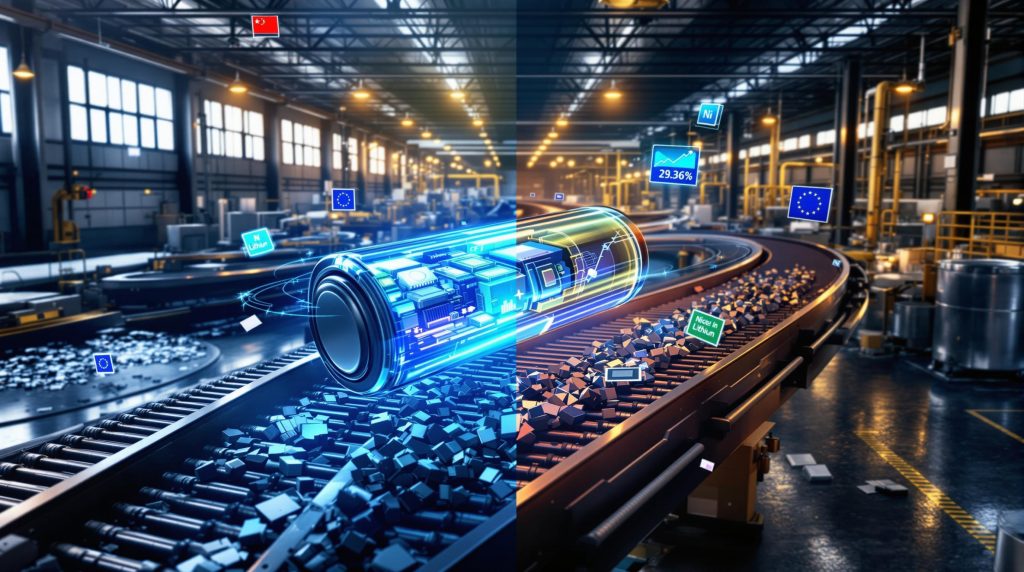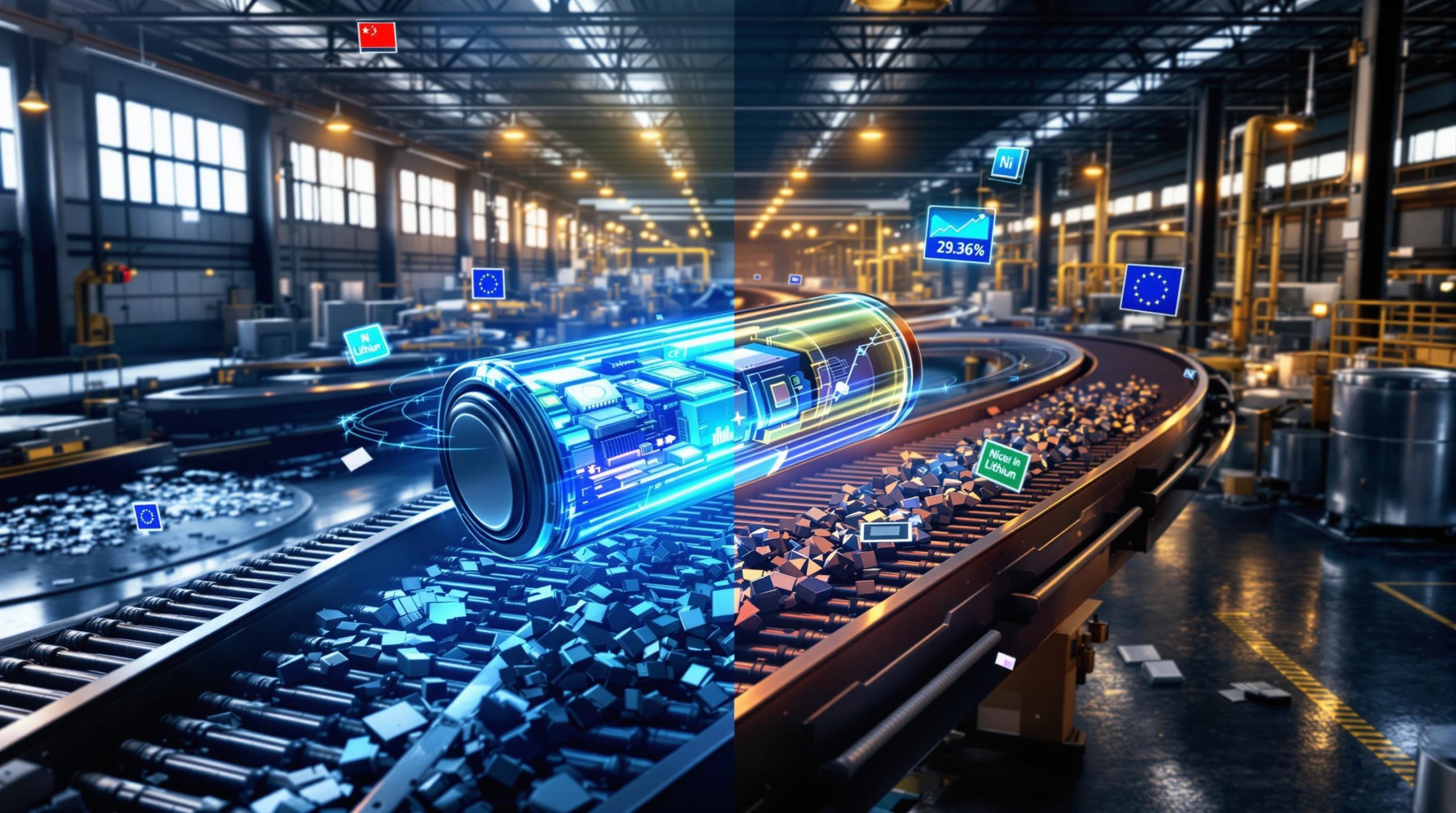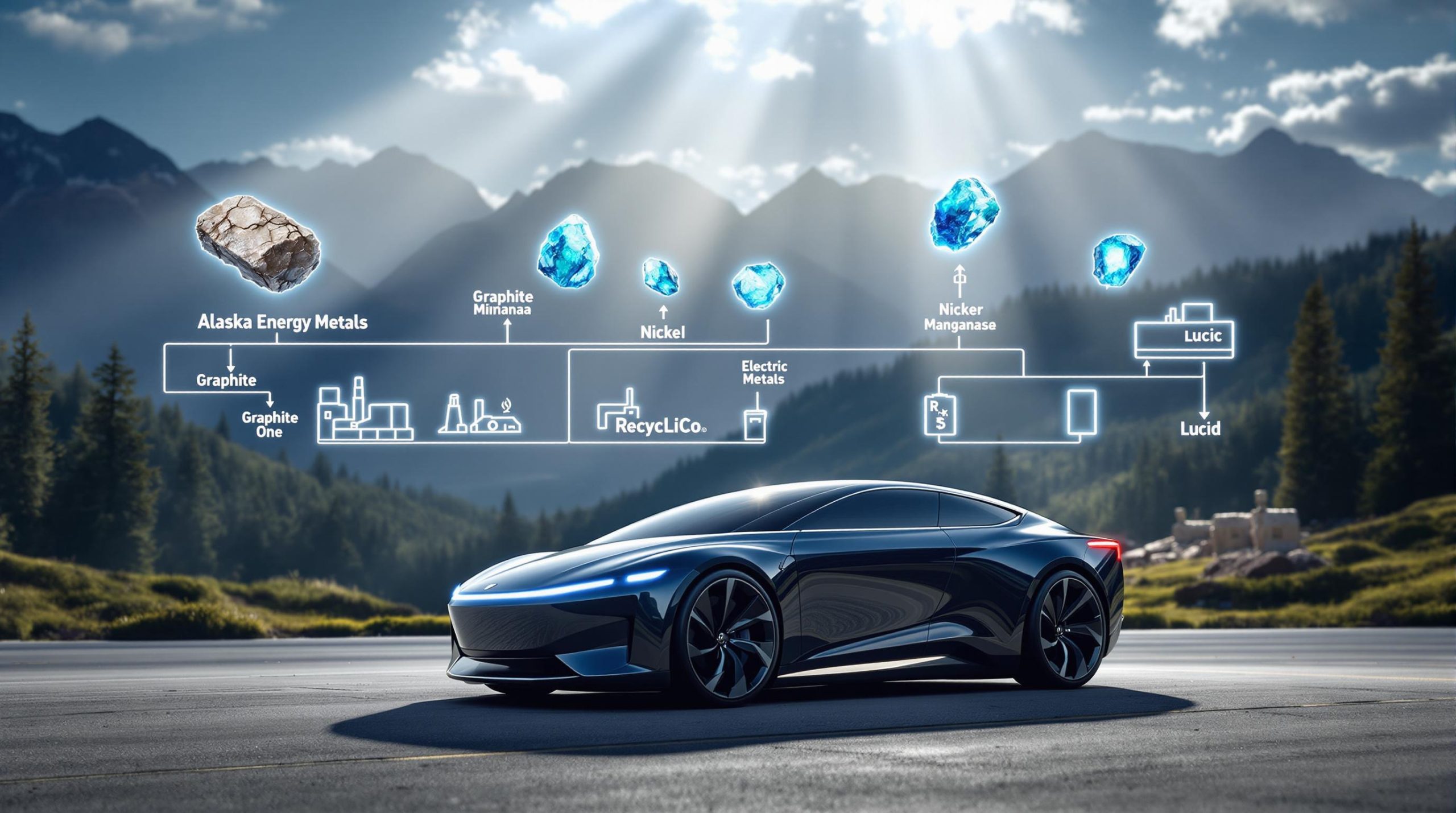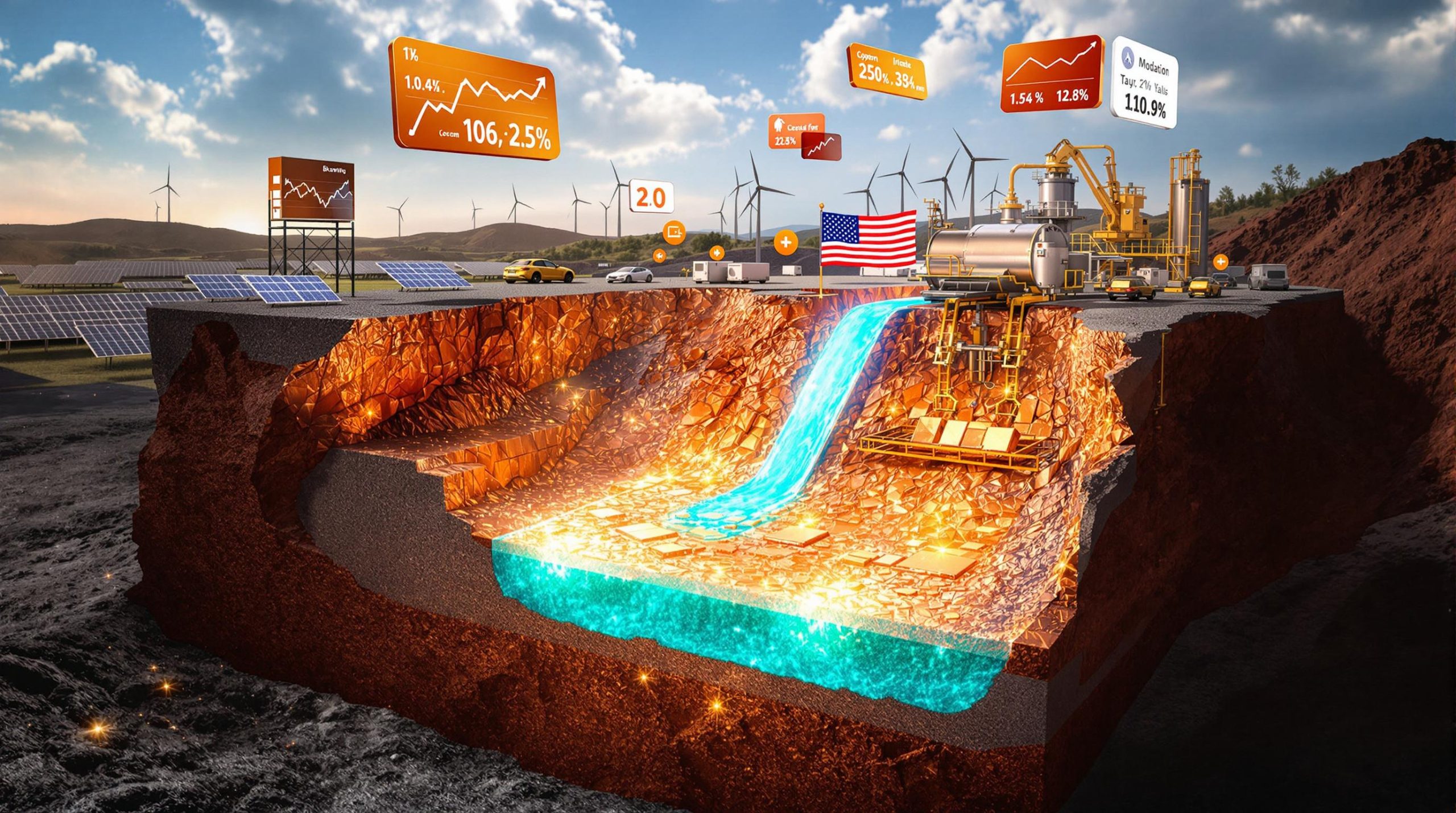The Growing Crisis in Battery Recycling Supply Chains
The lithium-ion battery recycling industry is facing a significant challenge that threatens to undermine its growth potential: a severe shortage of feedstock materials. This crisis is unfolding at a critical juncture in the industry's development, with recycling capacity expanding rapidly while available materials remain scarce. Recyclers across major markets are struggling to secure sufficient battery scrap and end-of-life materials to maintain operations, creating a competitive environment that has fundamentally altered the economics of battery recycling.
"Currently, we have shredding overcapacity in the country, so we [recyclers] are campaigning for the same material and the payables for the feedstock are pretty high," explains Anton Popiy, Market Intelligence and Product Manager at Ascend Elements, highlighting the intense competition in the U.S. market.
Key Factors Driving the Shortage
The feedstock shortage stems from several interconnected factors that have created a perfect storm for recyclers:
-
Delayed end-of-life volumes: The first wave of electric vehicle batteries has not yet reached recycling facilities in significant numbers, creating a gap between recycling capacity and available materials.
-
Manufacturing shifts: Battery cell production has increasingly concentrated in Asia, particularly China, reducing scrap availability in Western markets.
-
Production slowdowns: Reduced output at major battery manufacturers has further limited the availability of manufacturing scrap.
-
Competitive pressure: The rapid expansion of recycling capacity has created fierce competition for limited materials, driving up acquisition costs.
One European recycler noted to Fastmarkets: "Cells are being made in China, and Europe is an assembly line only. Earlier this year, we had supply from one battery manufacturer, but that has stopped now," highlighting the impact of global manufacturing shifts on regional feedstock availability.
How Is the Feedstock Shortage Affecting Different Regions?
The lithium-ion battery recycling feedstock shortage is manifesting differently across global markets, with each region facing unique challenges based on their manufacturing base, regulatory environment, and competitive landscape.
European Market Challenges
European recyclers are particularly hard-hit by the feedstock crisis, with many facilities operating well below capacity. The shortage has fundamentally altered market dynamics, reversing previous arrangements where recyclers received "gate fees" to process materials. Now, most must offer competitive payables to secure feedstock, and some are even returning to charging gate fees due to severe supply constraints.
"Because of the lack of scrap available, we now need to take a gate fee again. Low capacity utilization is badly damaging operating margins at European recyclers, because fixed costs are very high and we don't have the volume," revealed a European recycler to Fastmarkets in June 2025.
Manufacturing shifts have played a critical role in Europe's feedstock crisis. As battery cell production has increasingly concentrated in Asia, particularly China, European recyclers have lost access to valuable manufacturing scrap. The result is a significant discrepancy between announced recycling capacity and actual operational capacity.
Specific examples illustrate the severity of the situation:
- Reduced EV battery output at LG Energy Solution in Wrocław, Poland
- Production challenges at Samsung SDI in Göd, Hungary
- Uncertainty surrounding Northvolt's Revolt recycling facility, which was notably excluded from Lyten's takeover of remaining Northvolt assets
Asian Market Dynamics
In stark contrast to Europe, Asian markets—particularly South Korea—face a different set of challenges characterized by intense competition for imported materials and compressed margins.
Korean recyclers are aggressively pursuing black mass imports despite challenging economics. They're paying premium prices for feedstock while producing recycled, technical-grade materials that sell at discounted rates due to weak downstream market conditions.
"In terms of supply globally, we are seeing decreasing amounts of black mass produced. Due to competition [with the Southeast Asia market], we couldn't secure enough materials," a Korean recycler source told Fastmarkets in July 2025.
Another Korean recycler added: "Recyclers in Korea are still looking very actively for materials in the global markets, at least to keep their plants running."
China's recent policy change adds another dimension to the competitive landscape. As of August 1, 2025, China now allows black mass imports, though with strict impurity requirements. This Chinese battery recycling breakthrough creates new opportunities for producers of high-quality materials but also increases competition for already scarce resources.
North American Situation
The U.S. market mirrors global trends, with recycling capacity significantly exceeding available feedstock. Recyclers are "campaigning for the same material," as Anton Popiy from Ascend Elements described it, leading to high payables for limited feedstock.
Despite the challenges, North American recyclers benefit from a growing domestic battery manufacturing base that may eventually provide more consistent access to manufacturing scrap compared to their European counterparts.
What Are the Economic Impacts of the Feedstock Shortage?
The lithium-ion battery recycling feedstock shortage has triggered significant economic ripple effects throughout the recycling value chain, fundamentally altering pricing dynamics and challenging the business models of established recyclers.
Pricing Trends and Market Indicators
The most visible economic impact is seen in black mass payable rates, which have climbed to multi-year highs in key Asian import markets. According to Fastmarkets' weekly assessments, black mass NCM/NCA payable indicators for both nickel and cobalt in South Korea reached 77-83% on August 13, 2025, up from 75-81% week-on-week. This represents the highest level recorded since August 2023.
"Major plants which are running at high capacities – although not many recyclers are able to do that – are willing to pay very competitive payables to attract raw materials," explained a Korean recycler source.
Despite the overall increase in black mass values, the payable rates for lithium content have declined significantly. Current assessments show lithium payables at just 0-2%, unchanged week-on-week and equaling the lowest level since pricing began in 2023. This reflects broader weakness in lithium pricing, making lithium recovery less economically attractive for recyclers.
Black Mass Payable Indicators (August 2025)
| Metal | Payable Range | Trend | Reference Point |
|---|---|---|---|
| Nickel | 77-83% | ↑ from 75-81% | Highest since August 2023 |
| Cobalt | 77-83% | ↑ from 75-81% | Highest since August 2023 |
| Lithium | 0-2% | → Unchanged | Lowest since pricing began |
Operational Challenges for Recyclers
The economics of battery recycling are particularly vulnerable to capacity utilization issues due to the high fixed costs associated with these facilities. Without sufficient volume, recyclers struggle to cover their fixed costs, threatening the economic viability of their operations.
This dynamic has created a two-tier market:
-
Established recyclers with secured feedstock sources are able to maintain reasonable operating margins despite challenging market conditions.
-
Newer entrants without established supply chains face significant challenges acquiring sufficient materials at economically viable prices.
The quality of processed materials has become increasingly important in this competitive landscape. Companies that can produce high-quality black mass with low impurities can still command premium prices in key Asian markets, creating a quality-driven market segment that remains somewhat insulated from broader supply challenges.
How Are Battery Metal Prices Affecting the Recycling Economics?
The economics of lithium-ion battery recycling are closely tied to underlying battery metal prices, which provide the ultimate value recovery potential from recycled materials. Despite recent price rallies for both cobalt and lithium in 2025, battery metals prices remain significantly lower than they were three years ago, creating additional headwinds for recyclers.
Battery Metal Market Trends
The combination of high feedstock acquisition costs and relatively low output values has squeezed margins throughout the recycling chain. This effect is particularly pronounced in the Korean market, where recyclers are purchasing black mass at elevated prices while selling recycled technical-grade materials at discounted rates due to weak downstream demand.
The value of lithium in black mass has been especially impacted by broader market trends. In the Korean market, lithium's contribution to overall black mass value has decreased substantially over the past year amid weaker lithium pricing, making recycling this key metal less profitable for Korean buyers.
The Quality Premium
In this challenging economic environment, quality has become a key differentiator. Recyclers capable of producing black mass with low impurities and consistent composition can still command premium prices in key import markets such as South Korea. This quality premium helps offset some of the margin pressure created by high feedstock costs and relatively low metal prices.
For many recyclers, focusing on nickel and cobalt recovery has become increasingly important as lithium's contribution to overall economics has diminished. This shift has potential long-term implications for lithium recovery rates and circular economy objectives.
What Solutions Are Emerging to Address the Feedstock Shortage?
As the lithium-ion battery recycling industry grapples with persistent feedstock shortages, innovative companies are developing strategic responses to navigate this challenging landscape and position themselves for long-term success.
Industry Adaptations and Strategic Responses
Diversification of Feedstock Sources
Forward-thinking recyclers are expanding beyond their traditional focus on electric vehicle batteries to capture materials from:
-
Consumer electronics: Smartphones, laptops, and other portable devices contain valuable battery materials that can supplement automotive feedstock.
-
Energy storage systems: Grid-scale batteries and residential energy storage systems represent growing sources of potential feedstock.
-
Industrial applications: Batteries from material handling equipment, power tools, and other industrial applications provide additional feedstock opportunities.
This diversification strategy reduces dependence on automotive battery scrap during this transitional period when end-of-life electric vehicle batteries remain scarce.
Technological Innovations
Innovation is helping recyclers maximize value from limited materials through:
-
Enhanced pre-treatment processes: More efficient methods for battery disassembly and black mass production increase material recovery rates.
-
Flexible processing capabilities: Technologies that can handle a wider variety of battery chemistries expand the potential feedstock pool.
-
Impurity management: Advanced techniques for managing and removing impurities allow recyclers to process lower-grade materials while still producing high-quality outputs.
Companies able to produce black mass with low impurities and good quality can command premium prices in key Asian import markets such as South Korea, offsetting some of the challenges created by high feedstock acquisition costs.
Strategic Partnerships
The industry is increasingly recognizing that vertical integration and strategic partnerships offer potential solutions to feedstock security:
-
Direct relationships with battery manufacturers: These arrangements can provide more predictable manufacturing scrap flows.
-
Partnerships with automakers: Direct connections to vehicle end-of-life management ensure priority access to retired battery packs.
-
Consolidation within the recycling sector: Industry consolidation is beginning, with established players acquiring smaller competitors to secure their feedstock sources.
In Europe, newer post-treatment recyclers are actively seeking experienced talent, including ex-Northvolt staff with knowledge of scaling up recycling operations, to help navigate these challenging market conditions.
What Does the Future Hold for Battery Recycling?
The lithium-ion battery recycling industry is navigating a challenging transition period characterized by feedstock shortages and margin pressures. Looking ahead, several key factors will shape the industry's development and determine which companies successfully emerge from this challenging phase.
Industry Outlook and Projections
Medium-Term Supply Improvements
While the current shortage is acute, several factors point to improving feedstock availability in the coming years:
-
Maturing EV fleets: The first significant wave of electric vehicles will begin reaching end-of-life status within the next 3-5 years, providing a steadier stream of battery materials.
-
Manufacturing capacity growth: As battery manufacturing capacity expands globally, the volume of production scrap will increase correspondingly, benefiting recyclers with strong industry connections.
-
Product design evolution: Next-generation batteries increasingly incorporate design-for-recycling principles, improving material recovery economics.
Despite these positive trends, the transition period may continue to challenge recyclers for several years, particularly those without secured feedstock sources or financial resources to weather the current market conditions.
Regulatory Influences
Evolving regulations will play a crucial role in shaping future recycling dynamics:
-
Extended producer responsibility requirements: These regulations place greater responsibility on manufacturers for end-of-life management of their products, potentially creating more structured material flows.
-
Recycled content mandates: Requirements for minimum recycled content in new batteries would create guaranteed demand for recycled materials, potentially improving economics throughout the value chain.
-
Standardization efforts: Industry and regulatory moves toward greater standardization in battery design could significantly improve recycling economics by simplifying processing requirements.
Market Consolidation
The current challenging market conditions are likely to accelerate consolidation within the recycling industry:
-
Early-stage recyclers without strong feedstock relationships face significant challenges and may become acquisition targets.
-
Well-capitalized industry leaders are positioned to expand their market share through both organic growth and strategic acquisitions.
-
Integration across the value chain will likely increase as battery manufacturers, materials suppliers, and recyclers seek to create more resilient circular supply chains.
Industry Adaptation
The feedstock shortage is forcing the recycling industry to evolve, with several important adaptations emerging:
-
Increased focus on pre-processing efficiency: Maximizing material recovery from limited feedstock has become crucial to economic viability.
-
Geographic strategy refinement: Companies are reassessing facility locations to better align with both feedstock availability and output markets.
-
Business model innovation: New approaches to value sharing between feedstock providers and recyclers are emerging to create more sustainable economic relationships.
These adaptations will help the industry weather the current challenging period while building more resilient operations for the future. Companies pursuing innovative solutions like the Porsche battery recycling initiative are leading the way in developing sustainable approaches to the battery metals investment landscape.
FAQ: Lithium-Ion Battery Recycling Feedstock Shortage
What is causing the current lithium-ion battery recycling feedstock shortage?
The shortage stems from several interconnected factors: slower-than-expected growth in end-of-life battery volumes, reduced manufacturing scrap due to production shifts to Asia (particularly China), and increasing competition among recyclers as capacity has expanded faster than available materials. As one European recycler told Fastmarkets, "Cells are being made in China, and Europe is an assembly line only," highlighting the impact of manufacturing location on scrap availability.
How are recyclers adapting to the feedstock shortage?
Recyclers are implementing various strategies, including paying higher prices for materials, diversifying feedstock sources beyond automotive applications, investing in technologies to process lower-grade materials, and forming strategic partnerships to secure more reliable supply streams. Some recyclers have even returned to charging gate fees for processing materials, reversing the previous trend where they paid to secure feedstock.
When will the feedstock shortage likely improve?
Industry experts anticipate gradual improvement as more electric vehicles reach end-of-life and as battery manufacturing capacity matures in various regions. However, the transition period with limited feedstock availability may continue for several years before supply and demand reach better balance. The first significant wave of electric vehicle batteries is expected to reach recycling facilities within the next 3-5 years.
Which regions are most affected by the battery recycling feedstock shortage?
All major recycling markets are experiencing challenges, but European recyclers appear particularly impacted due to manufacturing shifts to Asia and reduced output at key European battery plants like LG Energy Solution in Wrocław, Poland, and Samsung SDI in Göd, Hungary. Asian markets, especially South Korea, face intense competition for materials, with Korean recyclers "looking very actively for materials in the global markets, at least to keep their plants running," according to industry sources. North American recyclers are dealing with significant overcapacity relative to available feedstock.
How does the feedstock shortage affect the economics of battery recycling?
The shortage has driven up input costs while output values remain constrained by relatively low battery metal prices. This has squeezed margins throughout the recycling chain, with many facilities operating well below capacity and struggling to cover their high fixed costs. According to Fastmarkets assessments, black mass payable indicators for nickel and cobalt have reached 77-83%, the highest levels since August 2023, reflecting the premium recyclers must pay to secure materials. Innovative approaches like the Livium recycling facility solution and investments in battery-grade lithium refinery capacity will be crucial to addressing these economic challenges.
Are You Prepared for the Next Big Mining Discovery?
Stay ahead of the market with Discovery Alert's proprietary Discovery IQ model, delivering instant notifications when significant mineral discoveries are announced on the ASX. Explore our dedicated discoveries page to understand how major mineral discoveries can generate substantial returns for prepared investors.




